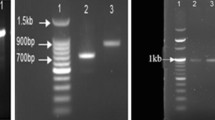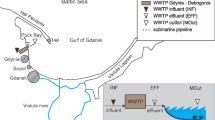Abstract
Five bacterial isolates were screened for resistance to organotin compound, i.e. tributyltin chloride (TBTC) up to 2 mM. The optimum pH, temperature and salinity for the growth of the isolates were found to be 7, 28°C and 2.5%, respectively. The isolates were tested for survival tolerance to heavy metals (mercury, cadmium and zinc) and co-resistance to antibiotics viz. ampicillin, kanamycin, rifampicin, streptomycin, penicillin, chloramphenicol, tetracycline, nalidixic acid and neomycin. Although our earlier study reported that these five bacterial strains are of different species of Pseudomonas, our present 16S rRNA gene sequence analysis revealed that all the strains are Pseudomonas aeruginosa. One of five isolates P. aeruginosa strain 25W could grow in mineral salt medium with 2 mM of TBTC as a sole source of carbon and survive up to 5 mM of TBTC. In presence of 2 mM of TBTC there was comparable up-regulation of 45 kDa protein in the cell extract of the 25W isolate was found indicating involvement of certain enzymes in TBTC resistance.




Similar content being viewed by others
Abbreviations
- TBTC:
-
Tributyltin chloride
- MSM:
-
Mineral Salt Medium
- 16SrRNA:
-
16S ribosomal RNA
- TBT:
-
Tributyltin
References
Barkay T, Miller SM, Summers AO (2003) Bacterial mercury resistance from atoms to ecosystem. FEMS Microbiol Rev 27(2–3):355–348
Bhosle NB, Garg A, Jadhav S, Harjee R, Sawant SS, Venkat K, Anil AC (2004) Butyltins in water, biofilm, animals and sediments of the west coast of India. Chemosphere 57:897–907
Blair WR, Olson GJ, Brinckman FE, Iverson WP (1982) Accumulation and fate of tri-n-butyltin cation in estuarine bacteria. Microb Ecol 8:241–251
Boopathy R, Daniels L (1991) Pattern of organotin inhibition of methanogenic bacteria. Appl Environ Microbiol 57:1189–1193
Bruins MR, Kapil S, Oehme FW (2003) Characterization of a small plasmid (pMBCP) from bovine Pseudomonas pickettii that confers cadmium resistance. Ecotoxicol Environ Saf 54:241–248
Cooney JJ (1995) Organotin compounds and aquatic bacteria—a review. Helgoland Meeresunter 49:663–677
Cooney JJ, Wuertz S (1989) Toxic effect of tin compounds on microorganisms. J Ind Microbiol 4:375–402
Dubey SK, Roy U (2003) Biodegradation of tributyltins (organotins) by marine bacteria. Appl Organometallic Chem 17:1–6
Esiobu N, Armenta L, Ike J, Esiobu JN (2002) Antibiotic resistance in soil and water environments. Int J Environ Health Res 12:133–144
Fent K (2003) Ecotoxicological problems associated with contaminated sites. Toxicol Lett 141:353–365
Fukagawa T, Suzuki S, Fukagawa K, Suzuki T, Takama K (1992) Isolation and characterization of tributyltin chloride resistant marine Vibrio. FEMS Microbiol Lett 93:83–86
Fukagawa T, Konno S, Takama K, Suzuki S (1994) Occurrence of tributyltin (TBT) and methyl mercury tolerant bacteria in natural seawater to which TBT was added. J Mar Biotechnol 1:211–214
Gadd GM (2000) Microbial interaction with tributyltin compounds, detoxification, accumulation and environmental fate. Sci Total Environ 258:119–127
Gerhardt P Murray RGE Wood WA Krug NR (1989) Gene transfer in gram positive bacteria. In: Methods for general and molecular bacteriology, chap 15. American Society for Microbiology, pp 353–402
Hallas LE, Cooney JJ (1981) Tin and tin resistant microorganisms in Chesapeake bay. Appl Environ Microbiol 41:466–471
Hummerjohann J, Kuttel E, Quadroni M, Ragaller J, Leisinger T, Kertesz MA (1998) Regulation of the sulfate starvation response in Pseudomonas aeruginosa: role of cysteine biosynthesis intermediates. Microbiology 144:1375–1386
Inaba K, Shiraishi H, Soma Y (1995) Effect of salinity, pH and temperature on aqueous solubility of four organotin compounds. Water Res 29:1415–1417
Kanthak DIJ, Bernstorff A, Jayaraman N (1999) Ship for scrap: steel and toxic wastes for Asia. Green Peace 5:26
Kiewitz C, Tummler B (2000) Sequence diversity of Pseudomonas aeruginosa: impact on population structure and genome evolution. J Bacteriol 182:3125–3135
Konstantinou IK, Albanis TA (2004) Worldwide occurrence and effects of antifouling paint booster biocides in the aquatic environment: a review. Environ Int 30:235–248
Kumar S, Tamura K, Jakobsen IB, Nei M (2001) MEGA2: molecular evolutionary genetics analysis software. Bioinformatics 17:1224–1245
Laemlli UK (1970) Cleavage of structural proteins during the assembly of the head of bacteriophage T4. Nature 227:680–685
Laurence OS, Cooney JJ, Gadd GM (1989) Toxicity of organotins towards the marine yeast, Debaryomyces hansenii. Microb Ecol 17:275–285
Mahtani S, Mavinkurve S (1979) Microbial purification of longifolene—a sesquiterpene. J Ferment Technol 57:529–533
McDonald L, Trevors JT (1988) Review of tin resistance, accumulation and transformation by microorganisms. Water Air Soil Pollut 40:215–221
Pain A, Cooney JJ (1998) Characterization of organotin resistant bacteria from Boston harbour sediment. Arch Environ Contam Toxicol 35:412–416
Pazirandeh M, Chrisey LA, Mauro JM, Campbell JR, Gaber BP (1995) Expression of the Neurospora crassa metallothionein gene in Escherichia coli and its effect on heavy metal uptake. Appl Microbiol Biotechnol 43:1112–1117
Pazirandeh M Welles BM Ryan RL (1998) Development of bacterium-based heavy metal biosorbents: enhanced uptake of cadmium and mercury by Escherichia coli expressing a metal binding motif. Appl Environ Microbiol 64:4068–4072
Pettibone GW, Cooney JJ (1986) Effect of organotins in fecal pollution indicator organisms. Appl Environ Microbiol 52:562–566
Pidiyar VJ, Jangid K, Dayanand KM, Patole MS, Gonzales JM, Kaznowski A, Shouche YS (2002) Phylogenetic affiliation of Aeromonas culicicola MTCC 3249T based on gyrB gene sequence and PCR-amplicon sequence analysis of cytolytic enterotoxin gene. Syst Appl Microbiol 26:197–202
Roy U, Bhosle S (2006) Microbial transformation of tributyltin chloride by Pseudomonas aeruginosa strain USS25 NCIM5224. Appl Organometallic Chem 20:5–11
Roy U, Dubey SK, Bhosle S (2004) Tributyltin chloride utilizing bacteria from marine ecosystem of west coast of India. Curr Sci 85:702–705
Sader HS, Jones RN, Silve JB, Sader HS (2002) Skin and soft tissue infection in Latin American medical center: four year assessment of the pathogen frequency and antimicrobial susceptibility patterns. Diagn Microbiol Infect Dis 44:281–288
Sanchez-Bayo F, Goka K (2005) Unexpected effects of zinc pyrithione and imidacloprid on Japanese medaka fish (Oryzias latipes). Aquat Toxicol 74:285–293
Spiers AJ, Buckling A, Rainey P (2000) The case of Pseudomonas diversity. Microbiology 146:2345–2350
Stasinakis AS, Thomaidis NS, Nikolaou A, Kantifes A (2005) Aerobic biodegradation of organotin compounds in activated sludge batch reactors. Environ Pollut 134:431–438
Stridh H, Fava E, Single B, Nicotera P, Orrenius S, Leist M (1999) Tributyltin-induced apoptosis requires glycolytic adenosine triphosphate production. Chem Res Toxicol 12:874–882
Suzuki S, Fuagawa T, Takma K (1992) Occurrence of tributyltin tolerant bacteria in tributyltin or cadmium containing sea water. Appl Environ Microbiol 58:3410–3412
Suzuki S, Tsukamoto KK, Fukagawa T (1994) The 16S rRNA sequence and genome sizing of tributyltin resistant marine bacterium, strain M-1. Microbiology 101:101–109
Tsing RK, Cooney JJ (1995) Action of tributyltin on enzymes on four bacteria. Environ Toxicol Chem 14:1113–1121
de Vicente A, Aviles M, Codina JC, Borrego JJ, Romero P (1990) Resistance to antibiotics and heavy metals of Pseudomonas aeruginosa isolated from natural waters. J Appl Bacteriol 68:625–632
White JS, Tobin JM, Cooney JJ (1999) Organotin compounds and their interaction with microorganisms. Can J Microbiol 45:541–554
Wuertz S, Miller CE, Pfister RM, Cooney JJ (1991) Tributyltin-resistant bacteria from estuarine and freshwater sediments. Appl Environ Microbiol 57:2783–2789
Acknowledgements
Authors are grateful to Dr S.K. Dubey, Goa University, for his suggestion and support. We are thankful to Dr Y.S. Shouche, NCCS, Pune, India for 16S rRNA analysis of the bacterial isolates and Dr K. Kannan, Wordsworth Center, N.Y. State Department of Health, USA for his valuable comment on this paper.
Author information
Authors and Affiliations
Corresponding author
Rights and permissions
About this article
Cite this article
Roy, U., Nair, D. Biodiversity of organotin resistant Pseudomonas from west coast of India. Ecotoxicology 16, 253–261 (2007). https://doi.org/10.1007/s10646-006-0125-x
Received:
Accepted:
Published:
Issue Date:
DOI: https://doi.org/10.1007/s10646-006-0125-x




